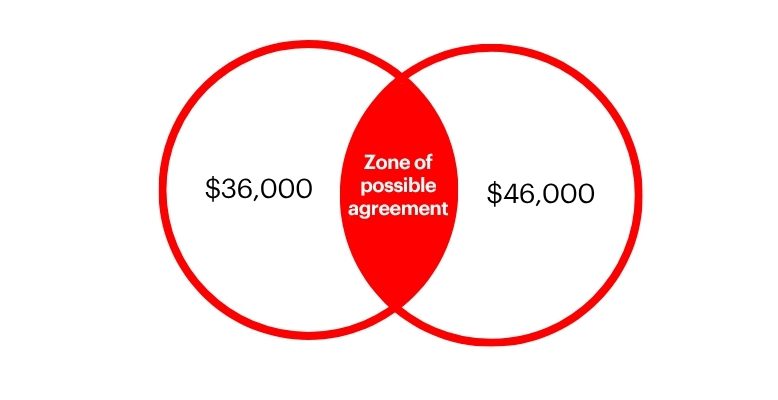
IESE Insight
Know this before negotiating your salary
Before you enter into your next salary negotiation, understand the relevant variables. Here are tips for win-win negotiations.
Imagine: You’ve just interviewed for three jobs. Two have made salary offers — one low, one high — but the third is yet to offer a figure. To complicate matters, the third job is for a newly created position in an entirely new line of business for which there is no precedent. How to approach this salary negotiation? What should you expect?
5 crucial factors to analyze before any negotiation
- Needs: If money is everything, then the negotiation is already set within the bounds of the high/low alternatives. However, there’s usually more. Might the learning opportunity count for more? The chance to grow and the potential for promotion? A shorter commute and better quality of life? Only you know your needs. And it is in this space where the negotiation can get more creative and deadlocks can be broken.
- Alternatives: It always helps to have available alternatives, such as existing offers, to give you options.
- Power: Assess what powers you could leverage, such as the desirable qualities and skills you possess, and those that set you apart from others.
- Reference values: Make sure you have some relative reference value, such as what similar jobs pay.
- Reservation price: Know your limit(s): What’s your walkaway price or the condition(s) that would break the deal?
Now let’s consider how these five factors play out in a hypothetical salary negotiation.
For the job candidate, these are their personal priorities and situation going into the negotiation:
- Needs: A job that offers good learning opportunities, leading to better prospects and faster promotion in an emerging field.
- Alternatives: They have already received two job offers elsewhere, one for $38,000 and one for $41,000.
- Power: They are ready, willing and able to start immediately.
- Reference values: They know that $35,000-$40,000 is the going salary in their field.
- Reservation price: They have decided they won’t go any lower than $36,000 provided that their other needs are met.
For the employer, these are the company’s priorities and situation going into the negotiation:
- Needs: A person who stays for at least two years and doesn’t leave quickly.
- Alternatives: Although experienced professionals can command $50,000, the company needs someone immediately, so they are willing to find someone less experienced but who can start sooner rather than later.
- Power: They are offering a great new learning opportunity with growth potential.
- Reference values: $34,500-$38,000 is the company’s internal reference, $45,000 is the external reference in the field where the company is moving into and $50,000 is the max for experienced professionals.
- Reservation price: The company is prepared to pay up to $46,000.
Ask probing questions to create higher value for yourself
Seen only from the job candidate’s side, you would be leaving a lot of money on the table if you only agreed a salary based on the high/low alternatives presented to you. You’d ask for “At least $41,000” or maybe even go lower if other conditions were met. This is why you need to ask:
- What are the needs of the company? How might recruiting you benefit the company strategically?
- How many alternatives does the company have if they don’t recruit you right now?
- What’s the maximum salary the company is willing to pay for this position?
In exploring these questions, particularly the reservation price and best alternative, you might be able to create higher value for yourself.
Remember, when entering into a negotiation, in addition to analyzing your own expectations, the other side will have done the same. The negotiation is about finding the zone of agreement, with each side not knowing the other’s situation or the value assigned to each factor.
Finding the zone of agreement

Instead of $41,000 (your top alternative offer), you might land at $42,000 (your best offer yet and reasonably within the company’s own reference value) plus have your other needs met besides.
So, do your homework and explore the other side’s needs and expectations: Doing so is a fundamental source of power and control in a negotiation.
A peep into the future: automated negotiations
As more of our face-to-face interactions are mediated via videos, phone calls, messaging apps and email, increasingly software systems and automated agents are being used to support negotiations.
In the salary negotiation example, you might have walked away happy that you got $36,000 but a software support system might have made a more complete analysis, controlling for all the various factors of both parties and taking the emotional component out of the process.
A common mistake is framing the negotiation negatively: You worry more about possible losses than potential gains, and you assume your counterpart’s interests are diametrically opposed to your own. A tech intermediary can serve to neutralize some of these mindsets.
In any case, ask yourself:
- Is it better for an automated agent or a human being to negotiate in this situation?
- How can this tool help me: In the preparation phase? In the offer/counteroffer phase? In presenting alternatives and the consequences of different decisions?
- What biases might be programmed into the system? For example, if the parameters are set according to high/low alternatives rather than taking account of individual expectations and needs, then the negotiation may be limited.
- How can this tool be used to overcome blocks and open new paths to continue negotiating?
SOURCE: Based on material from the book Negotiate Good, Negotiate Well by Kandarp Mehta and Guido Stein (McGraw-Hill, 2021).
This article was originally published as a Big Picture infographic in IESE Business School Insight magazine No. 160 (Jan.-April 2022).


